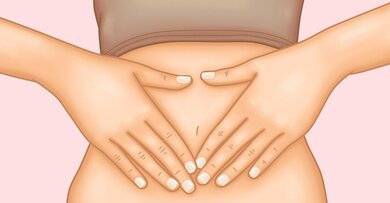
When you look at a baby calmly sleeping, you will observe how her/his breath is deep and concentrated in the belly. When we come into the world, we are physically connected to our mothers through the umbilical cord at our navels on our abdomen. About 5 weeks after conception, the umbilical cord begins forming and connects the embryo to the placenta and its mother, to received nutrients, water and oxygen, as well as to excrete waste. This continues on until that moment the cord is cut after birth. At this point in time, the child becomes its own being in itself and must begin its own respiration. When a child is calm, we will see that it breaths deep into the abdomen. However, life happens; stressors occur throughout our childhood into adulthood and we begin to forget that place in the abdomen where we were/are connected to life, if we are unaware. Then, we begin to breathe more superficially, moving the chest in order to receive more air but this does not nourish us in the long-term. In fact, it creates tight muscles and can trigger the sympathetic nervous system into the "fight-or-flight" stress mode.
Many traditions of the world have specific methods of breathing in order to support health or even to attain deep connection to the divine. One of these methods I have found to be very helpful and is almost universal to many traditions is "Diaphragmatic Breathing," "Abdominal Breathing" or as we in the Chinese medical tradition call "Natural Breathing." In the Chinese Qi Gong tradition, the main focus of this breath is the Lower Dan Tian (lower energy centre) in the area below the navel. We breathe deeply into the lower abdomen, allowing it to expand and contract freely as inhalation and exhalation occurs. This increases oxygen intake, increases circulation in the abdominal muscles, provides a massage for the internal organs and calms the entire body-mind, activating the parasympathetic nervous system.
Can you imagine how life would be if we were in a continuous state of calm? How would we make decisions? How would we interact or react to one another? How would we live life? Obviously, it is unrealistic to expect that we can always be in this state, as we do need a certain amount of "stress" to grow and develop physically, mentally and spiritually. But the longer we can stay in this state, the healthier it is for our minds and bodies, as well as for the people/environment around us. The aim of Natural Breathing is for us to return to what we once knew but perhaps forgot. It is innate to us and it just takes practice to remind our bodies-minds of something it already knows. If you keep a practice of 5-minutes daily for a year, your body will remember it for the rest of your life.
Personally, I practice this breathing technique almost all the time now for more than 20 years. It did not feel natural at first but with constant practice and patience it has become intuitive. When I am relaxed or stressed, I instinctively practice Natural Breathing. I consciously breathe this way when I get my blood pressure measured (which most times has a normal reading) or when I go to the dentist or when I have to do a test. I practice this way of breathing almost every night before I go to sleep, placing my hands on my abdomen, just focusing on the rising and falling of my breath as well as my abdomen till I fall asleep.
Below is a step-by-step guide to Natural Breath. Happy Breathing! :-)
Natural Breathing
- Find a comfortable position in lying, sitting or standing. Place both hands on your lower abdomen by your navel (like in diagram below).
- Begin by inhaling and exhaling into your abdomen. Observe if the abdomen rises and falls with the breath. If it does not, begin to sink the breath into the abdomen.
- Imagine your abdomen as a balloon, when you inhale, you are blowing air into the balloon enlarging it, and when you exhale the balloon is shrinking. In the beginning, this may feel forced or unnatural. Be patient and keep practicing, it will become natural when you practice it regularly for some time.
- Inhale and exhale only through the nostrils, expanding and contracting your abdomen respectively.
- Begin to slow down the breath, keeping a regular and an equal rhythm of inhalation and exhalation.
- If you have never done this before, begin by performing 10 breaths at least once a day. After a week of regular practice, begin extending it by increments of 5 and stay with this for another week before increasing the increments.
- You may practice this as often as you like in a day and even at night.
- Side-effects include digestive rumblings in the abdomen (stimulation of your natural digestive functions), calmness, relaxation, feeling well and healthy.
Image Baby from esudroff on Pixabay
Image Abdomen from Eduardo RS from Pixabay


 RSS Feed
RSS Feed